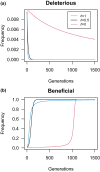Revisiting Dominance in Population Genetics
- PMID: 39114967
- PMCID: PMC11306932
- DOI: 10.1093/gbe/evae147
Revisiting Dominance in Population Genetics
Abstract
Dominance refers to the effect of a heterozygous genotype relative to that of the two homozygous genotypes. The degree of dominance of mutations for fitness can have a profound impact on how deleterious and beneficial mutations change in frequency over time as well as on the patterns of linked neutral genetic variation surrounding such selected alleles. Since dominance is such a fundamental concept, it has received immense attention throughout the history of population genetics. Early work from Fisher, Wright, and Haldane focused on understanding the conceptual basis for why dominance exists. More recent work has attempted to test these theories and conceptual models by estimating dominance effects of mutations. However, estimating dominance coefficients has been notoriously challenging and has only been done in a few species in a limited number of studies. In this review, we first describe some of the early theoretical and conceptual models for understanding the mechanisms for the existence of dominance. Second, we discuss several approaches used to estimate dominance coefficients and summarize estimates of dominance coefficients. We note trends that have been observed across species, types of mutations, and functional categories of genes. By comparing estimates of dominance coefficients for different types of genes, we test several hypotheses for the existence of dominance. Lastly, we discuss how dominance influences the dynamics of beneficial and deleterious mutations in populations and how the degree of dominance of deleterious mutations influences the impact of inbreeding on fitness.
Keywords: deleterious mutations; dominance; inference; natural selection; population genetics.
© The Author(s) 2024. Published by Oxford University Press on behalf of Society for Molecular Biology and Evolution.
Figures





Similar articles
-
Constraining models of dominance for nonsynonymous mutations in the human genome.PLoS Genet. 2024 Sep 20;20(9):e1011198. doi: 10.1371/journal.pgen.1011198. eCollection 2024 Sep. PLoS Genet. 2024. PMID: 39302992 Free PMC article.
-
Gene expression drives the evolution of dominance.Nat Commun. 2018 Jul 16;9(1):2750. doi: 10.1038/s41467-018-05281-7. Nat Commun. 2018. PMID: 30013096 Free PMC article.
-
Deleterious Variation in Natural Populations and Implications for Conservation Genetics.Annu Rev Anim Biosci. 2023 Feb 15;11:93-114. doi: 10.1146/annurev-animal-080522-093311. Epub 2022 Nov 4. Annu Rev Anim Biosci. 2023. PMID: 36332644 Free PMC article. Review.
-
The effect of antagonistic pleiotropy on the estimation of the average coefficient of dominance of deleterious mutations.Genetics. 2005 Dec;171(4):2097-112. doi: 10.1534/genetics.105.044750. Epub 2005 Aug 22. Genetics. 2005. PMID: 16118193 Free PMC article.
-
The population genetics of beneficial mutations.Philos Trans R Soc Lond B Biol Sci. 2010 Apr 27;365(1544):1195-201. doi: 10.1098/rstb.2009.0282. Philos Trans R Soc Lond B Biol Sci. 2010. PMID: 20308094 Free PMC article. Review.
Cited by
-
Evolution of Functional Genomic Diversity During a Bottleneck.Genome Biol Evol. 2025 May 30;17(6):evaf107. doi: 10.1093/gbe/evaf107. Genome Biol Evol. 2025. PMID: 40468974 Free PMC article.
-
Clinical progression and genetic pathways in body-first and brain-first Parkinson's disease.Mol Neurodegener. 2025 Jun 20;20(1):74. doi: 10.1186/s13024-025-00866-5. Mol Neurodegener. 2025. PMID: 40542411 Free PMC article.
-
Accessible, realistic genome simulation with selection using stdpopsim.bioRxiv [Preprint]. 2025 Mar 23:2025.03.23.644823. doi: 10.1101/2025.03.23.644823. bioRxiv. 2025. PMID: 40166307 Free PMC article. Preprint.
-
Constraining models of dominance for nonsynonymous mutations in the human genome.PLoS Genet. 2024 Sep 20;20(9):e1011198. doi: 10.1371/journal.pgen.1011198. eCollection 2024 Sep. PLoS Genet. 2024. PMID: 39302992 Free PMC article.
-
Neanderthal introgressed ancestry reveals human genomic regions enriched with recessive deleterious mutations.bioRxiv [Preprint]. 2025 May 7:2025.05.07.652751. doi: 10.1101/2025.05.07.652751. bioRxiv. 2025. PMID: 40654668 Free PMC article. Preprint.
References
-
- Abu-Awad D, Waller D. Conditions for maintaining and eroding pseudo-overdominance and its contribution to inbreeding depression. Peer Community J. 2023:3:e8. 10.24072/pcjournal.224. - DOI
Publication types
MeSH terms
Grants and funding
LinkOut - more resources
Full Text Sources

